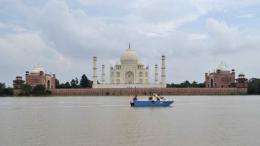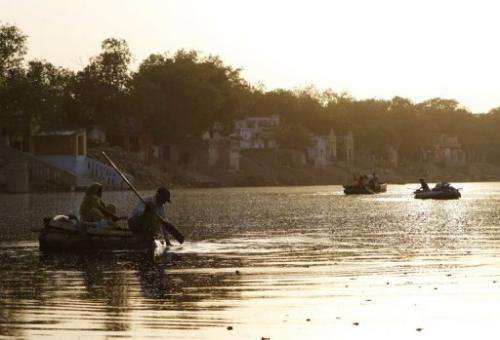Archeologists overseeing the upkeep of the Taj Mahal denied on Friday a press report that said the iconic structure could collapse in as little as two years because of its weakened foundations.
Archeologists overseeing the upkeep of the Taj Mahal denied on Friday a press report that said the iconic structure could collapse in as little as two years because of its weakened foundations.
The white marble mausoleum, known as the "monument of love" after it was built by a former Mughal emperor as a tribute to his dead wife, attracts four million tourists a year to the northern Indian town of Agra.
It stands on the banks of the depleted and polluted river Yamuna, which provides moisture to wooden structures that hold up the onion-shaped dome and its four minarets.
Earlier this week, Britain's Daily Mail newspaper quoted Agra's elected parliamentarian Ramshankar Katheria as saying the Taj would "cave in between two and five years" if conservation efforts were not launched.
The Archeological Survey of India (ASI), which began a major facelift for the Taj Mahal in 2007, dismissed the dire predictions for the 358-year-old monument.
"We have been having regular tests conducted and agencies including Survey of India have never pointed out such threats to the survival of the Taj Mahal," ASI's chief archeologist in Agra, I.D. Dwivedi, told AFP.
Katheria denied forecasting a collapse within five years but he told AFP that he had conveyed his fears for the future of the Taj to Indian Prime Minister Manmohan Singh and President Pratibha Patil more than once.
"I am demanding a high-level enquiry to analyse the severe threat posed to the wooden structures in the foundation of the Taj," the MP said.
Agra's MP Ramshankar Katheria says timbers supporting the Taj Mahal are turning brittle because the level of Yamuna is declining due to the over-extraction of water by residents and businesses.
He warned that the supporting timber was turning brittle because the level of Yamuna was declining due to the over-extraction of water by residents and businesses.
"The timber in the plinth of the Taj would soon corrode and termites could set in unless it quickly finds a source of moisture," Katheria said in an interview.
"The acrid dust from the dry riverbed is also dulling the domes of the Taj and the government must build a barrage across Yamuna to keep its water levels high," Katheria, who belongs to the main opposition BJP party, added.
The Taj, a popular backdrop to photos of tourists in India, was built by Mughal emperor Shah Jahan as a tomb for his beloved empress, Mumtaz Mahal, who died while giving birth to their 14th child in 1631.
India's Supreme Court in 1996 declared a 10,400-square-kilometre (4,015-square mile) area as a protected zone for the Taj Trapezium Zone after industries were found to be contributing to the monument's yellowing.
It ordered 292 coal-based factories to switch to natural gas or relocate outside the zone by April 30, 1997. Conventional vehicles have also been banned within a 500-metre radius of the building.
(c) 2011 AFP
























